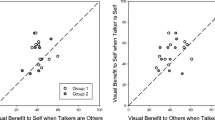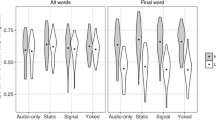Abstract
MOST verbal communication occurs in contexts where the listener can see the speaker as well as hear him. However, speech perception is normally regarded as a purely auditory process. The study reported here demonstrates a previously unrecognised influence of vision upon speech perception. It stems from an observation that, on being shown a film of a young woman's talking head, in which repeated utterances of the syllable [ba] had been dubbed on to lip movements for [ga], normal adults reported hearing [da]. With the reverse dubbing process, a majority reported hearing [bagba] or [gaba]. When these subjects listened to the soundtrack from the film, without visual input, or when they watched untreated film, they reported the syllables accurately as repetitions of [ba] or [ga]. Subsequent replications confirm the reliability of these findings; they have important implications for the understanding of speech perception.
Similar content being viewed by others
References
Binnie, C. A., Montgomery, A. A., and Jackman, P. L., J. Speech Hearing Res., 17, 619–630 (1974).
Liberman, A. M., Delattre, P. C., and Cooper, F. S., Am. J. Psych., 65, 497–516 (1952).
Author information
Authors and Affiliations
Rights and permissions
About this article
Cite this article
MCGURK, H., MACDONALD, J. Hearing lips and seeing voices. Nature 264, 746–748 (1976). https://doi.org/10.1038/264746a0
Received:
Accepted:
Issue Date:
DOI: https://doi.org/10.1038/264746a0
- Springer Nature Limited
This article is cited by
-
Continuous lipreading based on acoustic temporal alignments
EURASIP Journal on Audio, Speech, and Music Processing (2024)
-
Audiovisual integration in the McGurk effect is impervious to music training
Scientific Reports (2024)
-
Perception of temporal synchrony not a prerequisite for multisensory integration
Scientific Reports (2024)
-
Viewing angle matters in British Sign Language processing
Scientific Reports (2024)
-
Towards Language-Guided Visual Recognition via Dynamic Convolutions
International Journal of Computer Vision (2024)





